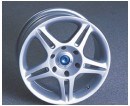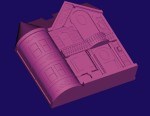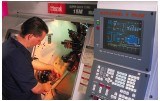Six Keys To Success In Single Piece Production
The seventh key is that the profits often come later.
It's hard to make money on a one-off job, because the chance to amortize the fixed cost is gone. That one unit has to absorb all of the programming, preparation, and setup costs that come before you can hit "cycle start." No shop knows this fact of life better than our shop, Mark Two Engineering (Miami, Florida). We have made one-off jobs our specialty. And we rarely turn a profit on them.
At least, not at first. One-off jobs for tooling like EDM electrodes can be profitable. However, far more of our single-piece runs are instead for rapid prototypes. These are functional parts that design engineers can examine and test, or perhaps just touch and feel before committing to the design. Often, the key to winning a rapid prototyping job is being able to deliver this throwaway part within just a few days. Thus, for a contract shop, rapid prototyping combines the worst of both worlds—a one-piece run and a brutally short leadtime. This is why so few shops want to take on rapid prototyping jobs. And there lies our opportunity. Mark Two is a new company. Our management consists of manufacturing veterans, but we opened our doors only last year. Our willingness to take on jobs no one else wants is what gives us an edge over established shops. In fact, these jobs often provide the only way for us to begin a relationship with customers who have a long history of dealing with other contractors. So while we may not make money on a prototyping job, we try to think further ahead than that. What if the prototype becomes a production part? If it does, then our shop already has the code, the process and the experience to machine that part efficiently. In other words, we have an edge when it comes time to quote on that job.
Already, there have been cases in which a relationship that began with prototyping has brought us production work. One example involves a manufacturer of scale model, functional "microjet" engines for hand-held miniature aircraft. This company now serves the hobby industry, but may soon serve the military as well—as in remote-controlled spy planes. We began our relationship with this company in part by machining Inconel engine component prototypes at a loss. Along the way, we learned the best ways to process these hard-to-machine parts. So when it came time to go into production, no shop was better qualified than we were to take on that job.
We are not yet to the point where production jobs that have come from one-off work are paying for the investment we continue to make in these jobs. In fact, another business we are engaged in is volume production of medical components on Swiss-type CNC lathes, and right now it is this large-volume work that effectively pays our bills.
However, all of our resources other than these lathes continue to be directed heavily toward short-run jobs, particularly rapid prototypes. And the success we have had with this work has given us some insight into what it takes to build business on the basis of one-piece, fast-turnaround jobs.
1. Don't be everything to every customer. Be good at something.
We are good with one particular CAD/CAM system, Pro/Engineer from Parametric Technology Corporation (Waltham, Massachusetts). Mark Two president Enrique Enriquez programs all of our jobs in Pro/E, and has written Pro/E postprocessors for all of our CNC machines used in rapid prototyping. We have invested heavily in making ourselves Pro/E "experts."
The payback is the promise this lets us make to a key niche of customers within the market for complex prototypes or tooling. We can tell engineers who happen to be designing in Pro/E that we can import and work with their designs without subjecting the file to translation. This means no data will be lost, and therefore the intent of the design will not be lost, either. Letting a customer instruct us electronically, just by supplying the Pro/E file, removes uncertainty and delay from the prototyping process.
A wheel prototype we manufactured for an automotive design studio illustrates this. The geometry of the complex, highly contoured part produced a milling program with a file size of 20 MB. However, because we had the luxury of "clean" geometry, we were able to generate this program and machine the part—exactly the part the designer had in mind—all within a single weekend.
2. For the customers you do serve, offer a range of options.
When it comes to CNC machines, we aspire to have at least one of everything. Our equipment currently includes a high speed machining center, a live tool lathe, and ram and wire EDM machines.
In addition, we offer more than just machining. We also manufacture parts through investment casting. We have all of the knowledge and equipment necessary for this process in-house, including a machine for making three-dimensional wax models. This machine, which is also programmed using Pro/E, makes the model used as a starting point in the investment casting process. This model is packed in foundry sand, then melted away to leave the mold impression behind.
The range of process options gives us an important advantage when we are competing for the chance to make a functional prototype of a metal part. Contractors who are more narrow in their process options force the customer to decide between casting and machining, or even between cutting and EDMing. But in many cases the customer is a design engineer who lacks the manufacturing expertise to choose among these processes.
We have that expertise. What is more, we have no vested interest in any one process. As a result, we can relieve a design engineer of the need to make process-related decisions. The designer can simply tell us the requirements for the part—related to geometry, accuracy, metal properties, and deadline—and let us decide what process or combination of processes is right for the job.
3. Embrace the technology.
We traveled the aisles of the 1996 International Manufacturing Technology Show like kids in a candy store. Once we had decided we would open a contract machine shop, we were determined to outfit it with the most sophisticated equipment we could afford. We were determined to buy not for our expertise, but to buy as much capability as we could, and let our expertise grow to match that capability over time.
This proved to be exactly the right decision. It gave us the ability to take on jobs that otherwise we would have had to turn away. For example, we resisted the idea of getting a wire EDM machine at first, but as soon as we started working with it, our minds opened to the expanded range of features we could machine. We no longer had to ask designers to change dimensions that were too precise to mill. Now, we had a way to serve the customer who came to us wanting a 0.0015-inch radius in his design.
Something similar could be said for our Mazak (Florence, Kentucky) vertical machining center. Mazak added an Ethernet card allowing us to feed complex programs into the control at the rate of 1 MB per second, instead of the less than 2 kB per second a typical DNC interface would allow. This means that when long programs are fed into the control while the machine is in-cut, we never have to set the feed rate artificially low to avoid data starvation. Mazak also tuned the servodrives of this machine for high feed rate contouring. These changes to the control system let us machine intricate contoured surfaces to finish tolerances at 200 ipm, where otherwise we would feed no faster than about 30 ipm.
Only this extra speed let us satisfy a customer in need of a series of electrodes for a very complex design—the shape of a lunchbox in the form of a Barbie dollhouse. The finishing electrode for the front of this "house" included stylized columns, door and window frames, ornamentation, and a balcony railing with elaborate posts (see illustration at right). The program for this part came to 5 million lines of code, for a file size of 32 MB. At the same time, the leadtime was very short. We needed all the high-speed precision our machining center could deliver, because our customer faced a hard deadline in the form of a looming back-to-school season.
The investment in advanced technology pays for itself primarily by helping us to win jobs like the lunchbox electrodes. However, this is not the only return. We have also observed these two side benefits:
Good service. In some cases, our willingness to buy top-of-the-line technology has turned us into a showcase for that technology's supplier. The supplier uses us as a model for prospective customers, and therefore goes to great lengths to support us when we need service for their products.
Good employees. What shop is not struggling to find qualified personnel today? We fill our ranks in part using student co-ops from the engineering department of a nearby university. However, when the students get a taste of the variety of manufacturing technologies they can work with in this shop, many of them want to stay on after graduation. That is why eight of our employees, out of 25 total, are degreed engineers.
4. Keep a well-stocked inventory.
We know the arguments for inventory reduction, and the economic benefits of ordering supplies on a just-in-time basis. However, low inventory just does not work for rapid prototyping.
The principal source of delay in any rapid prototyping job is often just the wait for exotic tooling or material. This is a delay we can not afford—not when some customers ask us for turnaround times of just two or three days. Therefore, our rule-of-thumb for tools and material is this: If we can't obtain it from a local supplier immediately, then we had better have it on hand.
We have drawers full of cutting tools—as close as we can get to one of everything we may need. We also have an engineer whose full-time job is to track and replenish tool inventory. And as for material: Aluminum we can obtain at will, but we have to keep reserves of the more exotic metals on our own shelves. For example, much of our rapid prototyping work is for the medical industry, so we keep ourselves well-supplied with the four steels most frequently used in medical applications. Even so, the material can go fast. We use it liberally, by necessity. We are rarely so lucky that the billet we have on hand approximates the dimensions and amount of material the customer requires. More likely, we saw away most of the material just to machine a much smaller part. One result is that this shop pays a high price for its throwaway fixture tooling. Much of it is made from scraps of 304L stainless.
If all of this sounds expensive, even wasteful, it is. However, the far greater waste would be if we missed the chance to win a long-term customer just because our leadtime to supply a prototype part was too long.
5. Pick the right horses.
This advice applies to both customers and suppliers. In either case, the companies a shop chooses as its partners should be able to go the distance.
Rapid prototyping relationships become profitable when the prototypes turn into production parts. So when we consider taking on a rapid prototyping job, we don't weigh the difficulty of that job nearly so much as we consider the long-term prospects for more work. For example, the agreement to machine parts for the maker of microjet engines was costly in the beginning. But now, our initial faith that this company was destined for success—and that the company would want us to share in that success—has paid off.
Supplier relationships also have to be measured for their value over the long term. We find this is particularly true of a tool supplier. No matter how well we try to stock our tool inventory, we still run into emergencies in which we are without a tool we desperately need. These situations make the relationship we have with our own South Florida-based tool supplier, Southern Tool, invaluable. I have called the president of Southern Tool at 10 p.m. to have him hand-deliver a particular reamer first thing the next morning. Service like this is worth a price. Perhaps we could save money in the short term by opening our tool orders up for competitive bid. However, for the sake of our long-term interests, the better choice is to continue to build on our relationship with this one trusted supplier.
The corollary to this is that a shop needs to keep its partner companies' long-term interests in mind—that is, not only customer interests, but supplier interests as well.
Bill Box, our chairman, grew the first business he founded to more than 1,000 employees. He learned this along the way: "Businesses fail because they try to optimize themselves over their customers and their vendors."
Focusing on the customer may seem elementary (Is it?), but key suppliers can be just as essential to the success of any business. Good suppliers who are well rewarded have an incentive to remain good suppliers.
"I look our vendors in the eye," Bill says. "I tell them, `I want you to make a lot of money off of us.' "
6. Have fun with it.
This advice relates to more than just machining. Work that is not fun is difficult. So if you are having fun, you have an edge over competitors who aren't.
We try to look for something we call the "cool factor" in jobs we take on. Jobs have cool factor when they give us reasons to be interested in the work over and above the manufacturing challenge. The Barbie dollhouse electrodes had cool factor, because we can now see the product of our own work on store shelves. And the microjet engine work has cool factor in spades! This characteristic alone is not enough reason to take on a job, but it is an excellent reason to give any job we are uncertain about the benefit of the doubt.
Striving to maintain our enjoyment in the work is simply another way we take the long-term perspective. When we lose money on a job in the short term, this can come back to us as the result of a rewarding customer relationship. But losing our enthusiasm is more serious. Over the long term, this can be much more difficult to win back.
About the author: Greg Murphy is co-founder and CEO of Mark Two Engineering, Miami, Florida.
Read Next
The Cut Scene: The Finer Details of Large-Format Machining
Small details and features can have an outsized impact on large parts, such as Barbco’s collapsible utility drill head.
Read More3 Mistakes That Cause CNC Programs to Fail
Despite enhancements to manufacturing technology, there are still issues today that can cause programs to fail. These failures can cause lost time, scrapped parts, damaged machines and even injured operators.
Read More


















.png;maxWidth=300;quality=90)







